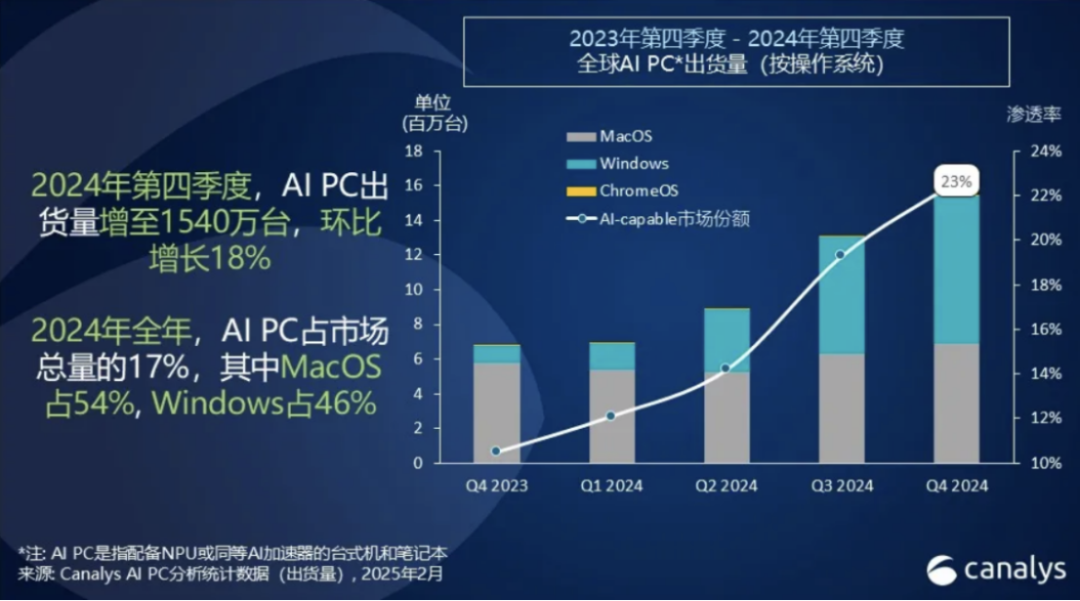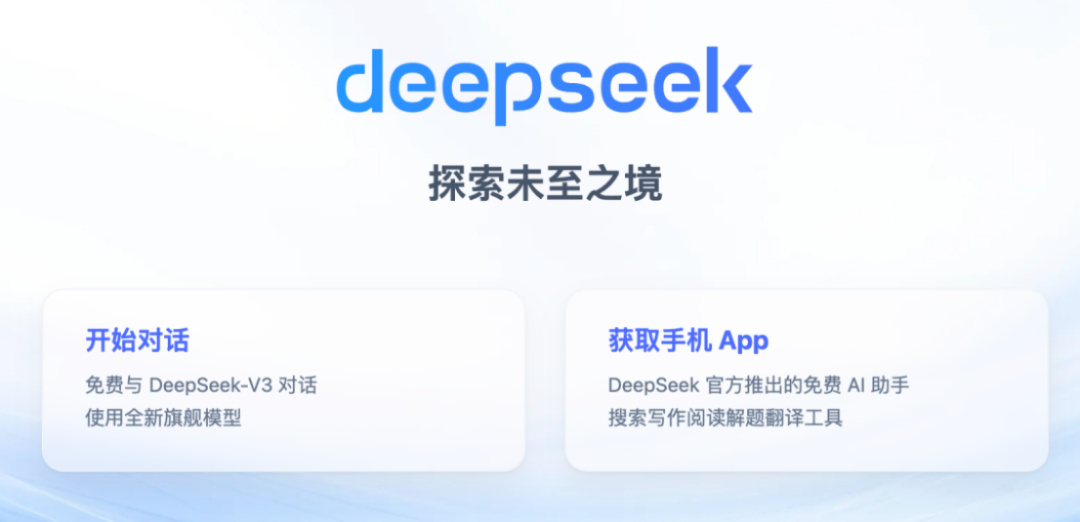Who is paying for AI PCs?
![]() 04/14 2025
04/14 2025
![]() 543
543

In 2025, AI is reshaping the global PC market at a speed far exceeding people's imagination. This year, different vendors have provided new insights into AI PCs.
For the first time, edge AI approached the performance boundary of cloud computing when Apple released the M4 series chip in March. The M4 Max chip, equipped in the top-of-the-line Mac Studio model, boasts 128GB of unified memory and 546GB/s bandwidth, enabling smooth local operation of the 200 billion-parameter Llama 3.1 large model with an inference speed exceeding 96 tokens/second (for the 8B model).
Enterprise AI PCs are also beginning to pursue profit. Intel launched the commercial vPro series of processors at MWC 2025, while AMD offers an eight-card W7900/W7800 server solution based on the vllm framework, providing a low-cost deployment solution for SMEs to use the DeepSeek R1 671B model.
The consumer market adopts a strategy of "cost-effectiveness + full-scenario collaboration". Xiaomi, Honor, and Lenovo have all launched their own AI PCs, driving AI PCs from being a "novelty" to a "necessity".
According to the latest Canalys data, global AI PC shipments reached 15.4 million units in the fourth quarter of 2024, accounting for 23% of total quarterly PC shipments. In mainland China, PC shipments reached 8.6 million units in the fourth quarter, with AI PCs accounting for up to 20% of this figure. In the fourth quarter of 2023, this share was only 7%, marking a threefold increase in one year.

Last year, AI PCs were still in their "enlightenment phase", utilizing local PC computing power for applications such as generative AI poetry, text dialogue, and text-to-image generation. Similar to AI assistants, these functions were not very practical in real-world use.
This year, the direction for AI PCs is clearer. AI PCs need to be able to assist people in various scenarios such as office work, entertainment, and healthcare through locally deployed applications.
For example, Honor's new AI PC strategy has been upgraded to AI PC2.0, with the newly released MagicBook Pro 14 being hailed as the "king of tuning". It is adjustable from the CPU, GPU, NPU, memory, voltage, fan, battery to audio, focusing on comprehensive and deep tuning of AI software and hardware self-collaboration. The CPU is equipped with
It is worth noting that Honor's new AI PC incorporates Chipsea Technology's EC (Embedded Controller) chip, the CSCE2010. This product is mainly developed for the mainstream consumer notebook market and can flexibly adapt to X86 and various domestic CPU platforms. The EC chip market has long been dominated by American and Taiwanese companies.
Xiaomi's AI PC product is the REDMI Book Pro16 2025. It is equipped with Intel's second-generation Core Ultra processor, featuring 16 cores and 24MB of cache. It integrates a new Intel Arc graphics card with an AI computing power of 96 TOPS and comes with 8400Mt of LPDDR5X ultra-high flash memory. In terms of AI capabilities, it can perform AI video content search and support AI document processing.
Apple's AI PC product is not a notebook but the Mac Studio. According to Apple, the Mac Studio equipped with the M3 Ultra can run large models with 600B parameters locally. It adopts a unified memory mechanism, making it less costly compared to deployment using NVIDIA GPUs and significantly reducing cooling requirements.
Therefore, it is not surprising that a large model studio announced on Twitter that it successfully ran the 8-bit version of R1 at a speed of 20 tokens per second using two Mac Studios equipped with 512GB M3 Ultra.
From a market perspective, the country provides subsidies of up to 2000 yuan (usually 15% of the selling price) for eligible AIPC products through the "trade-in" subsidy policy.
However, consumer awareness of AI PCs is insufficient. According to the "2024 AIPC Industry Trends and Potential Consumer Insights White Paper" jointly released by Tencent Marketing Insight (TMI) and GfK in October 2024, the report points out that the current awareness rate of AIPC among potential consumers is low (59%), and the concept of AIPC remains vague.
The reporter visited multiple offline stores and learned that compared to the AI functions of computers, more consumers are concerned about the computer's configuration. A salesperson at a Lenovo store said, "Few consumers pay for AI functions, and computers can install Doubao. Few users can clearly distinguish the functional differences between Doubao and Lenovo Xiaotian."
Of course, PC manufacturers will also actively demonstrate AI PC functions to consumers, but many users will perceive them as computer versions of smart assistants.
"Although the AI smart assistants that come with the manufacturer already support functions such as voice interaction, I still feel that cloud-based large models like Deepseek and Doubao are more powerful, and these large models can be directly installed and used on computers," a consumer who has experienced AI PCs told the reporter.
Compared to the unclear desire to purchase AI PCs on the consumer side, enterprises have a greater demand for AI PCs and are more willing to pay the cost.
On the one hand, corporate needs are clearer. With the widespread application of AI technology in various industries, enterprises need to leverage the powerful computing capabilities of AI PCs to handle complex tasks. For example, financial enterprises need to conduct risk assessments and market forecasts through AI PCs, while manufacturing enterprises need to optimize production processes and quality control using AI PCs.
On the other hand, enterprises are also more willing to invest in costs because AI PCs can bring higher production efficiency, better decision support, and stronger competitiveness. For example, enterprises can automate office processes through AI PCs, reducing labor costs, or improve product quality and production efficiency by optimizing production processes.
The official DeepSeek documentation indicates that local deployment of the DeepSeek large model must strictly follow the three-tier resource matching principle of "video memory - memory - storage". This also means that if the CPU is added, attention must be paid to the four core hardware components.

According to Hugging Face benchmarks, 4-bit quantization can compress the video memory footprint of the 7B-parameter DeepSeek-R1 model from 13GB to 4.2GB, but at the cost of about 8% accuracy loss.
Let's look at the hardware configuration required for the minimum 7B model:
The GPU requires an NVIDIA GTX 1080 (8GB video memory) or equivalent performance graphics card. The graphics card needs to support FP16 computing and be compatible with NVIDIA CUDA models. The CPU requires 4 cores or more, such as Intel i5/i7 or AMD Ryzen 5/7 series processors. 16GB of DDR4 memory is required. Memory is needed to store a large amount of data such as model parameters and intermediate calculation results, and 16GB of DDR4 memory can meet basic storage requirements to ensure the normal operation of the model. At least 20GB of solid-state drive capacity is required for storage.
To smoothly run models with 13B+ parameters, the hardware requirements are higher:
Since the size of video memory directly determines the scale of data that can be processed during model runtime, the larger the video memory, the larger the model that can be run. Therefore, the GPU video memory should be 24G or above, such as NVIDIA RTX 3090/4090 graphics cards. The CPU should have 8 cores or more, such as Intel i9 or AMD Ryzen 9 series processors. 32GB of DDR5 memory is required. Compared to DDR4, DDR5 memory has significantly improved speed and bandwidth. Storage should be a solid-state drive with a capacity of 1TB or more that supports the NVMe protocol.
Based on previous actual tests, computers from 6-7 years ago (e.g., equipped with GTX 1060 graphics card + 16GB memory) could barely run a 1.5B model with a generation speed of about 2-3 tokens/second. Mainstream configurations from the past 3-4 years (e.g., RTX3060 + 32GB memory) can smoothly run 7B/8B models (10+ tokens/second). Running a 32B model requires NVIDIA RTX30/40 series graphics cards (with video memory ≥ 12GB), but the generation speed is still limited by video memory bandwidth.
Looking at the current notebook options on the market, there are very few choices in gaming notebooks because the next cycle for gaming notebooks from major manufacturers will be tied to RTX50 series graphics cards for AIPC.
Currently, the highest-end configuration of the ROG Flow X 2025 can locally deploy the 70B version of DeepSeek, with the highest option being AMD Ryzen AI Max+395. In terms of AI performance alone, it is currently the most powerful 2-in-1 notebook.
The ingenuity of this notebook lies in not having a built-in dedicated graphics card but adopting a new integrated design that encapsulates high-performance GPU cores and high-speed memory into the CPU chip, enabling local deployment support for large-parameter AI models through large-capacity unified memory. The price is relatively expensive, with a pre-sale price of 20,999 yuan, reduced to 18,999 yuan after the national subsidy.
Of course, in terms of inference performance and other aspects, there is still a gap compared to professional graphics cards, but it is already the lowest-cost solution for local deployment of large-parameter AI models.
Currently, most notebooks still have difficulty running DeepSeek.
Acer's Aspire Go AI, priced at the 3000 yuan tier after national subsidies, is equipped with the Core Ultra 5-125H platform. Although it currently does not have an AI capability similar to Lenovo Xiaotian's "AI Assistant", Intel's native AI engine "AIGC" is compatible with all Ultra processors and also supports commonly used functions such as AI painting, document summarization, and report generation.
AI PCs priced at the 4000 yuan tier include the HP Star Book Pro 14 AI, REDMIBook Pro 14 2024, and Honor MagicBook Pro 14 2025, which basically all come with AI assistants. HP has "HuiXiaowei AI Assistant", Xiaomi has "Xiaoai Classmate", and Honor has YOYO Assistant, and they have officially accessed the DeepSeek large model. Compared to AIGC, the AI assistants built into these products have a wider range of applications, such as global callouts, webpage recognition, and document summarization, which are more convenient.
AI PCs priced at the 5000 yuan tier after national subsidies, such as the new ThinkBook 14+, use the Ultra 5-225H chip with a performance release of 70W. In terms of AI, Lenovo Xiaotian is the fastest-progressing AI assistant among traditional manufacturers and was likely the first traditional brand to announce full access to DeepSeek.
On March 14, it was reported that Microsoft's Windows system license for Huawei had expired this month and had not been extended. This means that Huawei's new notebook computers will completely bid farewell to pre-installed Windows in the future. A Huawei insider responded that the license given by the U.S. Department of Commerce had expired and had not been extended.
Last September, Yu Chengdong revealed in a live stream that due to sanctions, "Windows PCs may stop being supplied, and this may be the last batch. In the future, we will only use our HarmonyOS PCs."
There are reports that Huawei is planning to launch five new notebook computer products, including the 2024 versions of the MateBook D 14, D 16, 14, GT 14, and X Pro. These new products will all use the Linux system. Due to the open-source nature of the Linux system, no additional licensing fees are required, which can reduce the overall cost of the computer.
There are also reports that Huawei's self-developed commercial AI notebook is expected to be released in April, equipped with a fully integrated DeepSeek large model and using Kunpeng CPUs and HarmonyOS PC systems for chips and operating systems.
Previously, Huawei's Qingyun series of commercial PCs achieved nearly 100% self-research rate, with processors, operating systems, and other core components being independently developed, building full-stack controllability from hardware to software. In terms of AI PCs, Huawei has launched AI PC products equipped with local agents and large edge models. Taking the MateBook series as an example, it supports edge DeepSeek technology through a heterogeneous computing power architecture of CPU+GPU+NPU, realizing powerful "personal AI assistant" functions and significantly improving office efficiency.
Will Huawei's next PC be a HarmonyOS AI PC? It's worth looking forward to.





